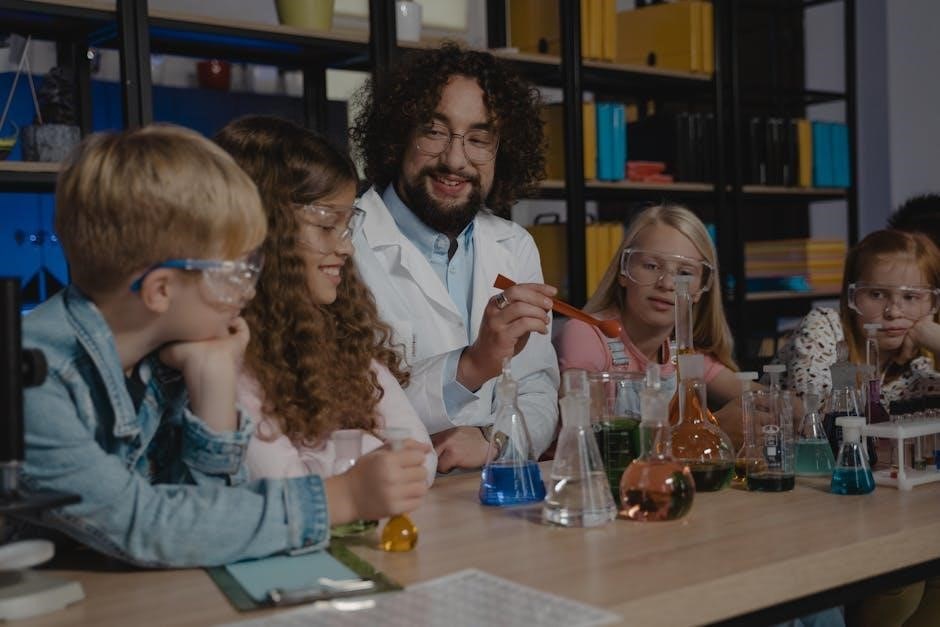
General Laboratory Safety Rules for Students
Students must follow all laboratory safety rules to ensure a secure environment. Essential apparel like lab coats and safety goggles is mandatory. Eating or drinking is strictly prohibited in the lab. Always adhere to teacher instructions and school policies, especially during emergencies. Report any accidents or spills immediately to maintain safety standards.
1.1 Essential Safety Apparel
Lab coats and safety goggles are mandatory in the laboratory to protect against chemical splashes and spills. Students must wear closed-toe shoes and tie back long hair to prevent accidents. Protective gloves should be used when handling hazardous materials or sharp objects. Proper attire ensures personal safety and prevents exposure to harmful substances. Anyone not wearing the required safety gear will not be permitted in the lab. Adhering to these guidelines is crucial for maintaining a safe learning environment.
1.2 Prohibition of Food and Drink in the Lab
Eating, drinking, chewing gum, or smoking is strictly prohibited in the laboratory. Food and beverages can become contaminated with hazardous substances, posing serious health risks. Additionally, consuming items in the lab can lead to distractions, increasing the likelihood of accidents. Students must avoid bringing food or drink into the lab to maintain a safe environment. This rule ensures that the focus remains on lab activities and minimizes potential hazards. Failure to comply may result in being asked to leave the lab. Adhering to this policy is essential for the safety and well-being of all students and staff involved in laboratory work.
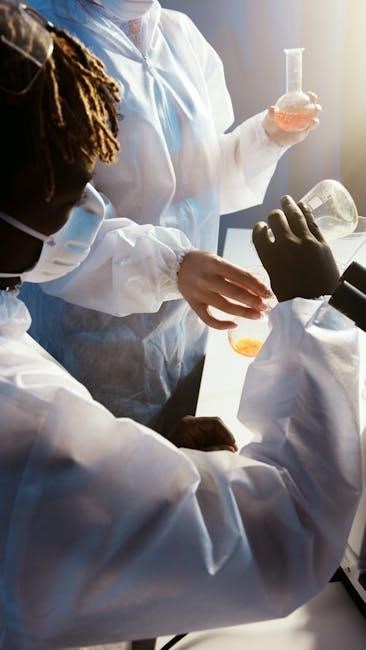
Personal Protective Equipment (PPE)
Lab coats, safety goggles, gloves, and closed-toe footwear are essential PPE in laboratories. They protect students from chemical, biological, and physical hazards, ensuring a safer working environment.
2.1 Safety Goggles and Eyewear
Safety goggles are essential for protecting eyes from chemical splashes, flying particles, and other hazards in the lab. Students must wear department-approved goggles at all times when handling hazardous materials. Regular eyewear, including glasses or contact lenses, does not provide sufficient protection. Goggles must have a snug fit and wraparound protection to ensure complete coverage. Students who fail to wear proper eyewear will not be permitted to participate in lab activities. Instructors may provide specific guidelines for goggles based on the experiment’s risks. Always inspect goggles for damage before use and clean them properly after handling chemicals. Remember, eye protection is critical to preventing irreversible injuries in a laboratory setting.
2.2 Lab Coats and Protective Clothing
Lab coats and protective clothing are crucial for safeguarding students from chemical splashes, spills, and other laboratory hazards. Students must wear a lab coat made of appropriate materials, such as cotton or flame-resistant fabric, to protect skin from potential exposure. Lab coats should be tied properly to avoid loose ends that could catch fire or interfere with equipment. Additionally, long hair and loose jewelry must be secured to prevent accidents. Open-toed shoes and casual clothing are prohibited in the lab. Students who fail to wear proper protective clothing will not be allowed to participate in lab activities. Always inspect lab coats for damage before use and clean them after handling chemicals. Proper attire ensures a safer laboratory environment for everyone involved.
2.3 Safety Gloves and Footwear
Safety gloves and footwear are essential protective gear in laboratory settings. Gloves protect hands from chemical spills, biological agents, and sharp objects. Choose gloves made of materials resistant to the substances being handled. Footwear must be closed-toed and sturdy to prevent injuries from falling objects or spills. Avoid wearing sandals or open-toed shoes, as they offer no protection. Always inspect gloves for holes or wear before use. Remove gloves and wash hands thoroughly after handling hazardous materials. Wearing proper footwear ensures stability and reduces the risk of accidents. Students not adhering to these guidelines may be asked to leave the lab. Proper hand and foot protection is vital for maintaining a safe working environment for everyone.
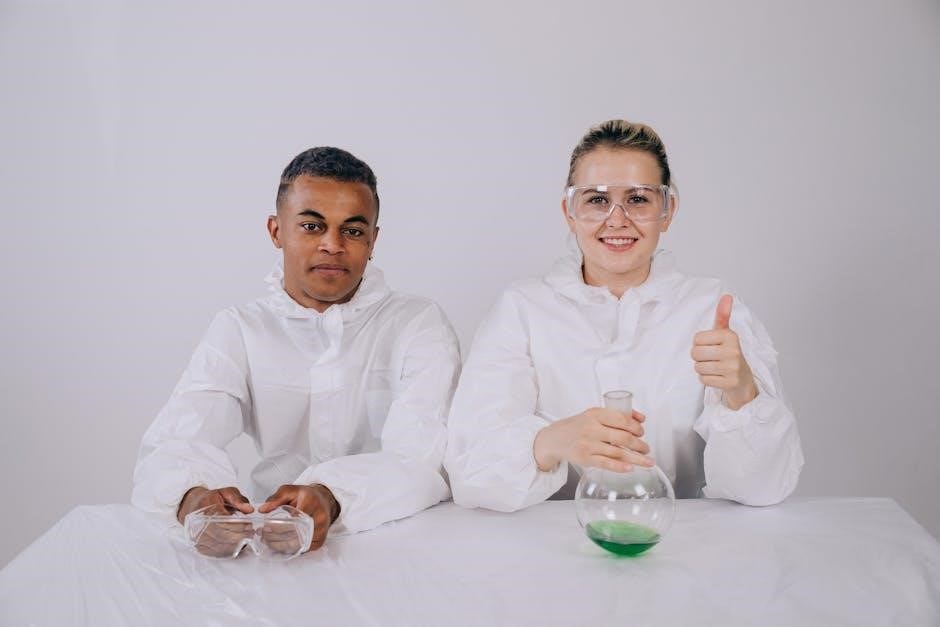
Emergency Procedures in the Laboratory
Report all accidents and spills immediately. Evacuate the lab using emergency exits and assemble at designated areas. Follow evacuation procedures and teacher instructions during emergencies to ensure safety.
3.1 Reporting Accidents and Injuries
Students must immediately report all accidents, injuries, or equipment damage to the instructor. Timely reporting ensures prompt medical attention and prevents further incidents. Documenting incidents helps maintain safety standards and accountability in the lab. Instructors will guide the process, ensuring proper procedures are followed. Students should not leave the area until the situation is resolved. Prompt reporting is crucial for everyone’s safety and well-being.
3.2 Cleaning Up Chemical Spills
Students must clean up chemical spills immediately to prevent accidents. Evacuate the area if the spill is hazardous. Use appropriate spill kits and neutralizing agents as instructed. Wear protective gear like gloves and goggles. Contain the spill to prevent spreading and ventilate the area if needed. Dispose of waste according to lab guidelines. Report the incident to the teacher, even if minor. Proper cleanup ensures safety and prevents environmental hazards. Always follow specific procedures for different types of chemicals. Never attempt to clean a spill without proper training or equipment. Timely action helps maintain a safe laboratory environment for everyone.
3.3 Evacuation and Emergency Exits
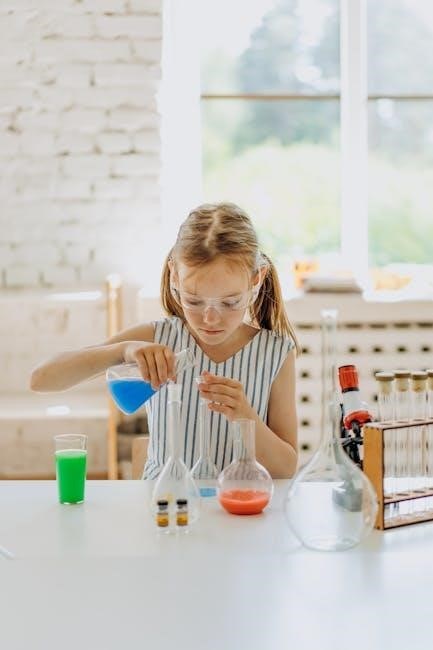
Students must familiarize themselves with emergency exit routes and follow evacuation procedures during drills or actual emergencies. Stay calm and listen to instructions from teachers or lab supervisors. Do not use elevators during evacuations. Assist anyone needing help, but do not risk your own safety. Move quickly and orderly to the designated assembly point outside the building. Do not re-enter the lab until authorized by school staff or emergency responders. Know the location of all emergency exits and ensure they are unobstructed. Practice evacuation drills regularly to prepare for real-life situations. Always prioritize safety and follow established protocols to minimize risks during emergencies.
Chemical Handling and Safety
Handle hazardous chemicals with care, wearing appropriate PPE. Follow instructions for proper use and storage to prevent accidents and exposure. Always label chemicals clearly and dispose of them safely.
4.1 Proper Use of Hazardous Chemicals
Always read and understand chemical labels before use. Wear appropriate PPE, such as gloves and goggles, to protect against exposure. Follow teacher instructions and manufacturer guidelines for handling hazardous substances. Never mix chemicals without authorization, and avoid skin contact. Use fume hoods when working with volatile or toxic chemicals to prevent inhalation. Ensure all procedures are conducted in well-ventilated areas. Keep chemicals away from heat sources or open flames. Dispose of waste properly, adhering to school and environmental regulations. Refer to Safety Data Sheets (SDS) for specific handling and emergency procedures. Proper use of hazardous chemicals is crucial to maintaining a safe laboratory environment for everyone.
4.2 Storage and Disposal of Chemicals
Chemicals must be stored in properly labeled containers, away from incompatible substances. Ensure storage areas are secure, well-ventilated, and protected from extreme temperatures. Dispose of chemicals according to school and environmental regulations. Use designated containers for hazardous waste and never pour chemicals down sinks or drains. Always consult Safety Data Sheets (SDS) for specific disposal instructions. Check expiration dates and dispose of outdated chemicals safely. Store chemicals in their original containers with labels intact to avoid confusion. Never leave chemicals unattended or in unauthorized areas. Proper storage and disposal prevent accidents and environmental contamination, ensuring a safe laboratory environment for everyone.
Equipment Usage and Safety
Always use laboratory equipment as instructed by teachers. Ensure equipment is in good condition and follow safety guidelines. Regular maintenance is essential for safe operation.
5.1 Safe Handling of Laboratory Equipment
Always handle laboratory equipment with care and follow proper techniques. Ensure you are authorized to use the equipment and understand its function. Wear safety goggles when operating equipment that may emit harmful substances or particles. Avoid touching hot, sharp, or moving parts without proper protection. Never use damaged or malfunctioning equipment, as it can pose serious risks. Keep long hair and loose clothing tied back to prevent entanglement. Familiarize yourself with emergency shut-offs and follow the manufacturer’s guidelines. Regularly inspect equipment before use and report any issues to your instructor. Proper handling ensures safety and prevents accidents, making it a critical part of lab protocols.
5.2 Regular Maintenance of Equipment
Regular maintenance of laboratory equipment is crucial for ensuring safety and functionality. Always inspect equipment before use, checking for damage or wear. Properly lubricate moving parts and ensure all electrical connections are secure. Clean equipment after each use to prevent contamination and extend its lifespan. Follow the manufacturer’s maintenance schedule and guidelines. Report any malfunctioning or damaged equipment to the instructor immediately. Label and store equipment correctly to avoid misuse. Keep records of maintenance activities to track service history. Regular upkeep prevents accidents, ensures accurate results, and prolongs equipment life, fostering a safe and efficient lab environment for everyone.
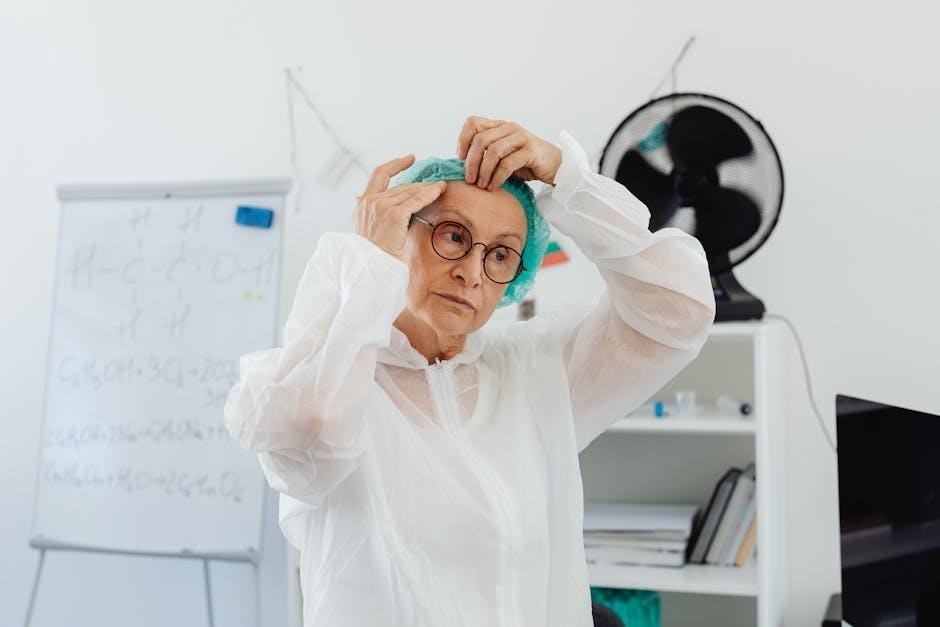
School and Laboratory Policies
Adhere to all school and laboratory policies. Sign safety contracts and follow teacher instructions. Familiarize yourself with emergency procedures and lab rules to ensure a safe environment.
6.1 Following Teacher Instructions
Students must strictly follow all instructions provided by teachers in the lab. This ensures adherence to safety protocols and helps prevent accidents. Teachers guide students through proper procedures, handling of equipment, and use of chemicals. Ignoring instructions can lead to serious risks. Always listen carefully and ask questions if unsure. Teachers are responsible for demonstrating safe practices and monitoring activities. Their guidance helps create a controlled environment where learning is safe and effective. By following instructions, students contribute to a secure and efficient laboratory setting for everyone involved. This is crucial for both individual and collective safety in academic labs.
6.2 Signing Safety Contracts and Agreements
Students are required to sign safety contracts or agreements before participating in lab activities. These documents outline essential safety rules and expectations for behavior in the laboratory. By signing, students acknowledge their responsibility to follow safety protocols, wear required PPE, and avoid prohibited actions like eating or drinking in the lab. The contract also emphasizes the importance of adhering to teacher instructions and reporting accidents immediately. Failure to comply with the terms of the agreement may result in being asked to leave the lab. This practice ensures that all students are aware of and commit to maintaining a safe learning environment. It is a critical step in promoting accountability and safety in academic laboratories.